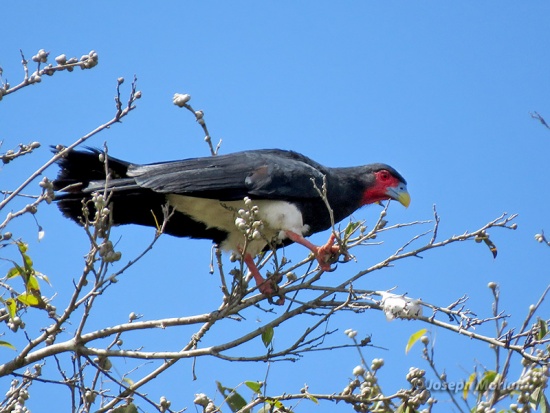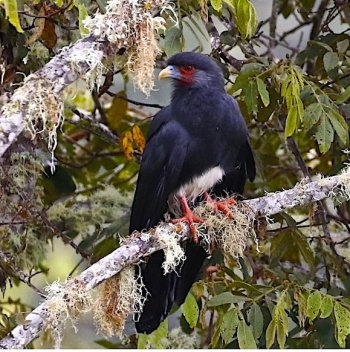(→References: Updated and expanded; honoring recommended citations.) |
(→External Links: Additional GSearch for common name. GSearch Checked template) |
||
| (3 intermediate revisions by one other user not shown) | |||
| Line 1: | Line 1: | ||
| − | [[Image: | + | [[Image:Red-throatedCaracaraIMG 6981.jpg|thumb|550px|right|Adult<br />Photo © by {{user|jmorlan|Joseph Morlan}}<br />Rio Marañon, Nauta Creek, Nauta, Loreto, [[Peru]], 14 June 2019]] |
;[[:Category:Ibycter|Ibycter]] americanus | ;[[:Category:Ibycter|Ibycter]] americanus | ||
| Line 10: | Line 10: | ||
Young birds lack the red throat | Young birds lack the red throat | ||
==Distribution== | ==Distribution== | ||
| − | [[Image:Red-throated CaracaraSJ.jpg|thumb| | + | [[Image:Red-throated CaracaraSJ.jpg|thumb|350px|right|Subadult<br />Photo © by {{user|Stanley+Jones|Stanley Jones}}<br />Oxapampa, [[Peru]], 18 August 2017]] |
[[Central America]] and [[South America]]:<br /> | [[Central America]] and [[South America]]:<br /> | ||
'''Central America''': Formerly [[Mexico]] to [[Panama]], this species has declined severely, and may now effectively be limited to a few locations in [[Costa Rica]] and to eastern Panama.<br /> | '''Central America''': Formerly [[Mexico]] to [[Panama]], this species has declined severely, and may now effectively be limited to a few locations in [[Costa Rica]] and to eastern Panama.<br /> | ||
| Line 21: | Line 21: | ||
==Behaviour== | ==Behaviour== | ||
====Diet==== | ====Diet==== | ||
| − | |||
Their diet consists mostly of the eggs and larvae of wasps and bees. They are most often seen in branches from the middle of the tree to the canopy. | Their diet consists mostly of the eggs and larvae of wasps and bees. They are most often seen in branches from the middle of the tree to the canopy. | ||
====Breeding==== | ====Breeding==== | ||
| + | [[Image:Red-throated CaracaraAA.jpg|thumb|350px|right|Photo © by {{user|andyadcock|Andy Adcock}}<br />Uiparu, [[Venezuela]], 14 January 2016 <!--EDITORS: this image does not appear in the Gallery-->]] | ||
They build a stick nest. | They build a stick nest. | ||
==References== | ==References== | ||
| Line 36: | Line 36: | ||
==External Links== | ==External Links== | ||
| + | Search the Gallery using the scientific name: | ||
{{GSearch|Ibycter+americanus}} | {{GSearch|Ibycter+americanus}} | ||
| + | Search the Gallery using the common name: | ||
| + | {{GSearch|"Red-throated Caracara"}} | ||
| + | {{GS-checked}} | ||
| + | <br /> | ||
| + | <br /> | ||
| + | |||
[[Category:Birds]] [[Category:Ibycter]] | [[Category:Birds]] [[Category:Ibycter]] | ||
Latest revision as of 21:40, 9 September 2022
- Ibycter americanus
Identification
43–61 cm (17-24 in)
Adult
- Black overall plumage
- Red bare skin on throat
- White belly
Young birds lack the red throat
Distribution
Central America and South America:
Central America: Formerly Mexico to Panama, this species has declined severely, and may now effectively be limited to a few locations in Costa Rica and to eastern Panama.
South America: from Colombia, Venezuela, the Guianas, Ecuador, south to Peru, northern Bolivia and southern Brazil.
Taxonomy
Habitat
Primary rainforest and forest edges, open grassland with scattered trees, secondary-growth woodland, often along rivers. In Honduras, also (is? or was?) found in pine savannah. (Different sources disagree as to whether this species can utilize open areas).
Behaviour
Diet
Their diet consists mostly of the eggs and larvae of wasps and bees. They are most often seen in branches from the middle of the tree to the canopy.
Breeding
They build a stick nest.
References
- Clements, J. F., T. S. Schulenberg, M. J. Iliff, D. Roberson, T. A. Fredericks, B. L. Sullivan, and C. L. Wood. 2018. The eBird/Clements checklist of birds of the world: v2018. Downloaded from http://www.birds.cornell.edu/clementschecklist/download/
- Ridgely & Gwynne 1989. Birds of Panama. Princeton Paperbacks. ISBN 0691025126
- Howell & Webb, 1995. A guide to the birds of Mexico and northern Central America. Oxford University Press. ISBN 0198540124
- Restall et al. 2006. Birds of Northern South America. Yale University Press. ISBN 9780300124156
- Ber van Perlo. 2009. A field guide to the Birds of Brazil. Oxford University Press, New York, NY, USA. ISBN 978-0-19-530155-7
- Bierregaard, R.O., Jr & Kirwan, G.M. (2019). Red-throated Caracara (Ibycter americanus). In: del Hoyo, J., Elliott, A., Sargatal, J., Christie, D.A. & de Juana, E. (eds.). Handbook of the Birds of the World Alive. Lynx Edicions, Barcelona. (retrieved from https://www.hbw.com/node/53188 on 2 August 2019).
- Davis, C. and S. McCann (2014). Red-throated Caracara (Ibycter americanus), version 1.0. In Neotropical Birds Online (T. S. Schulenberg, Editor). Cornell Lab of Ornithology, Ithaca, NY, USA. https://doi.org/10.2173/nb.retcar2.01
- Global Raptor Information Network. 2019. Species account: Red-throated Caracara Ibycter americanus. Downloaded from http://www.globalraptors.org on 2 Aug. 2019
- Schulenberg, T. S. & Stotz, D. F. & Lane, D. F. & O'Neill, J. P. & Parker III, T. A. & Egg, A. B. (2010). Birds of Peru: Revised and Updated Edition. Princeton: Princeton University Press. ISBN 978-0691130231
Recommended Citation
- BirdForum Opus contributors. (2024) Red-throated Caracara. In: BirdForum, the forum for wild birds and birding. Retrieved 23 June 2024 from https://www.birdforum.net/opus/Red-throated_Caracara
External Links
Search the Gallery using the scientific name:
Search the Gallery using the common name:
GSearch checked for 2020 platform.






